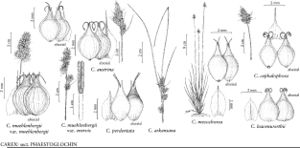Carex leavenworthii
Amer. J. Sci. Arts, ser. 2, 2: 246. 1846.
Plants without conspicuous rhizomes. Culms 10–80 cm, 1–2.4 mm wide basally, 0.5–1 mm wide distally. Leaves: sheaths tight, green or, sometimes, green-and-white-mottled, fronts hyaline; ligules to 2 mm, usually longer than wide; widest leaf blades 1.1–3(–4) mm wide. Inflorescences forming dense heads, with 3–8 spikes, 0.7–2 cm × 4.5–9 mm; proximal bracts to 2 cm; spikes with 6–10 ascending or spreading perigynia. Pistillate scales hyaline with green midvein, ovate, 1.5–2.5 × 0.9–1.2 mm, not more than 1/2 length of perigynia, apex acute to cuspidate. Anthers 0.6–1.7 mm. Perigynia pale green, veinless or weakly veined abaxially, 2.5–3.5 × 1.5–2.1 mm, body ovate, widest at 0.25–0.4 length of body, margins smooth or serrulate distally; beak 0.3–0.8 mm, apical teeth 0.1–0.3 mm. Achenes circular, 1–1.5 × 1–1.5 mm.
Phenology: Fruiting late spring.
Habitat: Dry grasslands, roadsides, open forests, forest edges, lawns
Elevation: 100–300 m.
Distribution

Ont., Ala., Ark., Calif., D.C., Fla., Ga., Ill., Ind., Iowa, Kans., Ky., La., Md., Mich., Miss., Mo., Nebr., N.J., N.Y., N.C., Ohio, Okla., Pa., S.C., Tenn., Tex., Va., W.Va., Wis.
Discussion
Carex leavenworthii is introduced in California and Wisconsin. Carex leavenworthii is easily confused with C. cephalophora and consequently may be overlooked.
Selected References
None.
